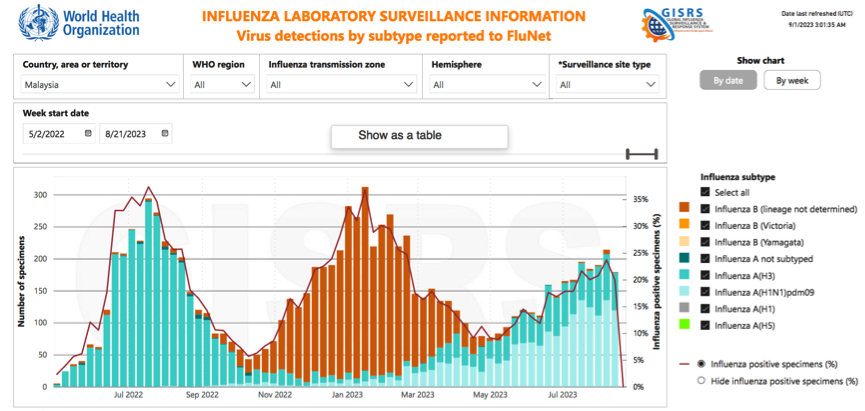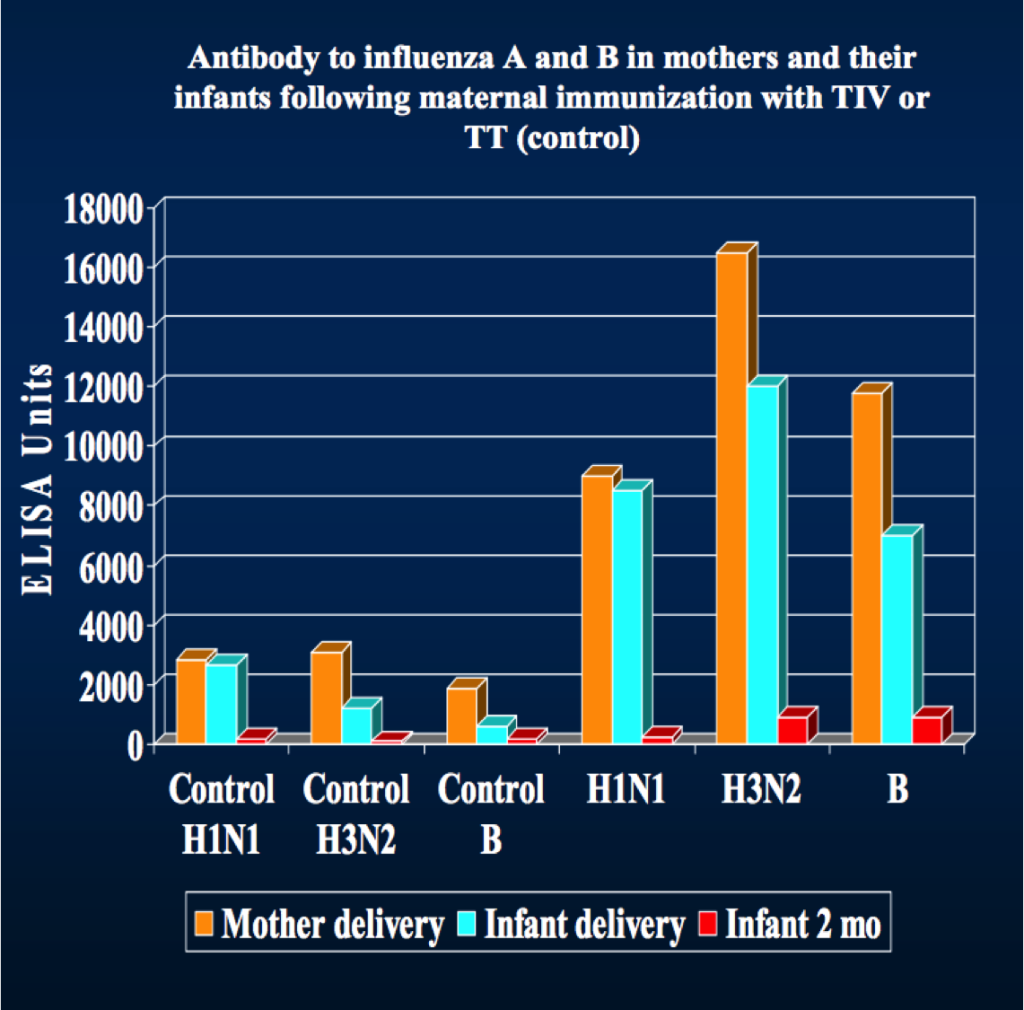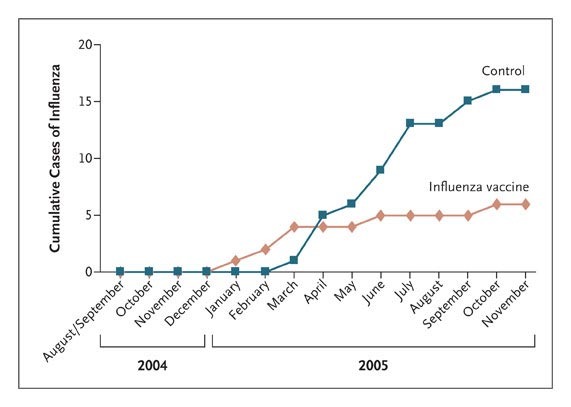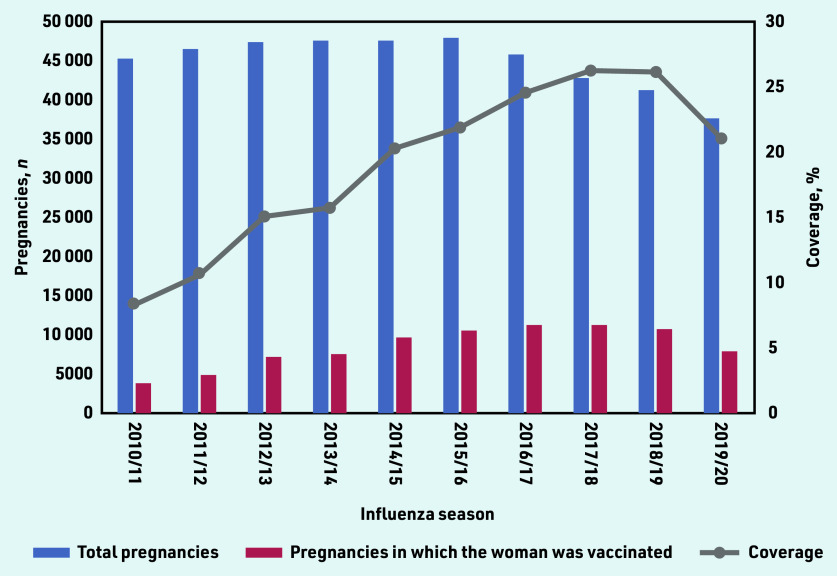Malaysia is still in the midst of an outbreak of influenza. At its peak, from August 7 to 13, 2023, the Malaysian Influenza Laboratory Surveillance reported to FluNet that 23.7 per cent of the specimens tested were positive for influenza. The breakdown was 63 per cent influenza A (H1N1), 34 per cent influenza A (H3), and 3 per cent influenza B (lineage not determined).

The Association of Private Hospitals Malaysia (APHM) first sounded the alarm on July 29, 2023, reporting that private hospitals may soon run out of beds due to a surge in influenza cases.
The Malaysian Influenza Working Group (MIWG) and their partners called upon the Ministry of Health (MOH) to seriously consider “free life-saving influenza vaccination for Malaysian seniors to combat severe influenza and ease the burden on the health care system”.
This brief focuses on the serious impact of influenza on two other high-risk groups, namely pregnant mothers and young infants. It demonstrates the potential return on investment (ROI) for a powerful public health intervention, i.e. vaccination, whereby one vaccine shot in the pregnant mother protects both the high-risk gravid mother and her baby from a potential fatal vaccine preventable disease (VPD).
The pregnant woman will experience changes in her cardiovascular, respiratory, and immune system, among others, which makes her more vulnerable to severe illness, due to the influenza virus.
Compared to non-pregnant women, pregnant women with influenza are at higher risk of requiring admission to hospitals, and more likely to require ICU care and assisted ventilation.
This is made worse if she has pre-existing comorbidities or pregnancy-induced conditions, e.g. pregnancy-induced hypertension or gestational diabetes which would adversely impact perinatal and neonatal outcomes.
The 2009 H1N1 influenza pandemic was associated with excess morbidity and mortality among pregnant women.
Random controlled trials and observational studies of pregnant women suggest influenza vaccination may reduce the risk of mild to moderately severe influenza illness by 50 per cent.
A retrospective study of over two million pregnancies from 2010 to 2016, across four countries in five regions reported that the influenza vaccine was effective in preventing 40 per cent of laboratory confirmed influenza hospitalisations during pregnancy.
Taken together, these data strengthens the rationale for influenza vaccination programmes for pregnant women.
Maternal immunisation with the trivalent influenza vaccine (TIV) has been associated with a significant increase in antibodies against influenza A and B in mothers and their babies. This active placental transfer of influenza antibodies has been shown to confer protection to the otherwise susceptible babies.

One of the earliest studies from Bangladesh showed that maternal influenza vaccination has significantly reduced (up to 63 per cent) laboratory-proven influenza illness in infants aged up to 6 months of age. It has also been associated with 29 per cent and 36 per cent reductions in rates of acute respiratory illness (ARI) with fever in infants and mothers, respectively.
Hospitalisations related to influenza infection was also shown to be reduced among women who were vaccinated during pregnancy.
The influenza vaccine is not effective in infants younger than six months. Therefore, passive immunisation of fetuses through trans-placental antibodies would be the best strategy to prevent influenza in these vulnerable newborns.

The inactivated quadrivalent influenza vaccine can be given to all pregnant women during any trimester.
Following the administering of the maternal influenza vaccine, no serious adverse events following immunisation (AEFI) were reported within 42 days of vaccination. There were also no significant differences in pregnancy outcomes (including caesarean delivery and premature delivery) and infant medical outcomes up to six months of age.
Heinonen and colleagues found no association between influenza vaccination in the first four months of pregnancy and any malformation or organ-system specific malformations.
Since then, there has been at least 20 studies to reaffirm that the influenza vaccine is safe during pregnancy.
Seasonal influenza vaccine (SIV) uptake in the United Kingdom has increased each season from 2010/11 (8.4 per cent) to 2017/18 (26.4 per cent), but then dropped to 21.1 per cent in 2019/20.

Prior to the 2009 H1N1 influenza pandemic, the uptake of the vaccine in pregnant American women was 15 per cent. This increased to 50 per cent during the pandemic and has been consistent at this level. The objective of the United States Healthy People Goal 2020 is to achieve 80 per cent.
Available data shows that the overall influenza coverage rate in Malaysia is a low 3 per cent. In a 2017 Malaysian study, 67 out of 386 (17.3 per cent) participants claimed to have received their annual influenza vaccine during pregnancy.
A survey conducted by Immunise4Life (IFL) found that very few respondents are aware that Tdap (21.8 per cent) and influenza (26.9 per cent) vaccinations are recommended during pregnancy, compared to the need for Covid-19 (72.8 per cent) and tetanus or ATT (63.7 per cent) vaccinations.
Tropical Malaysia experiences a perennial transmission of the influenza virus. The uptake of the influenza vaccine among high-risk pregnant Malaysian women is still low.
Much needs to be done by the health authorities and health care professionals to increase awareness of maternal immunisation, whereby a single dose of maternal influenza vaccine provides a considerable two-for-one benefit, protecting both mothers and their young infants.
Dr Musa Mohd Nordin and Dr Husna Musa are paediatricians.
- This is the personal opinion of the writer or publication and does not necessarily represent the views of CodeBlue.





